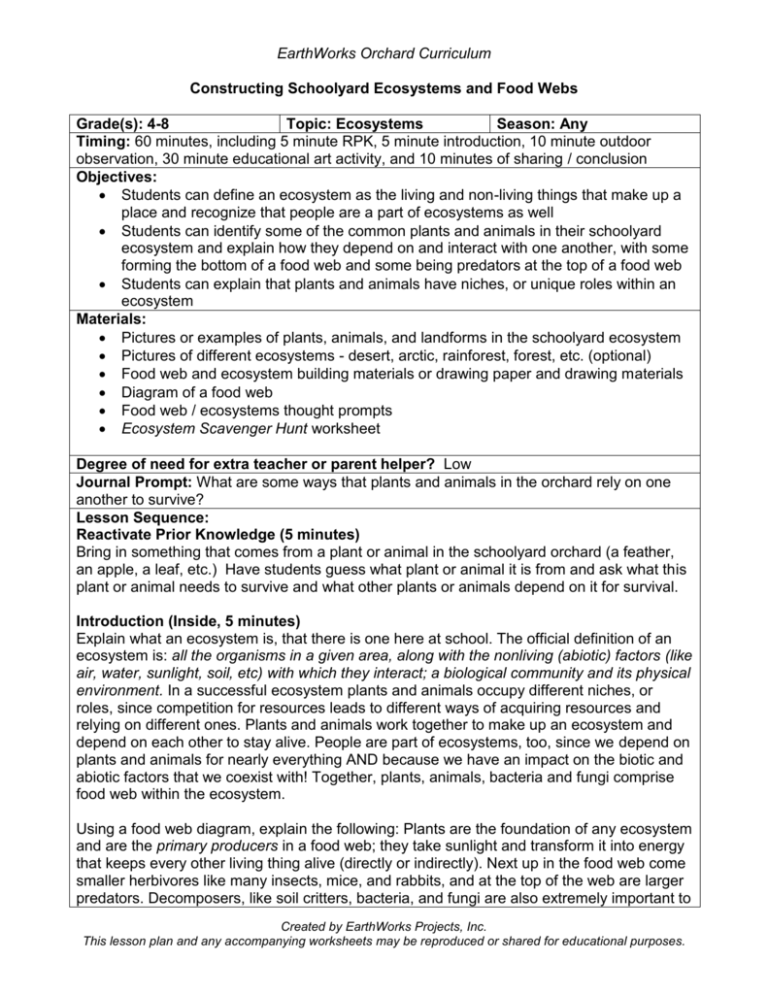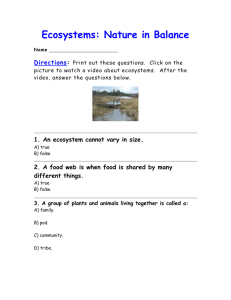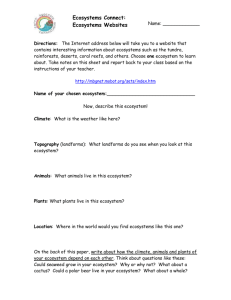Constructing Schoolyard Ecosystems and Food Webs
advertisement

EarthWorks Orchard Curriculum Constructing Schoolyard Ecosystems and Food Webs Grade(s): 4-8 Topic: Ecosystems Season: Any Timing: 60 minutes, including 5 minute RPK, 5 minute introduction, 10 minute outdoor observation, 30 minute educational art activity, and 10 minutes of sharing / conclusion Objectives: Students can define an ecosystem as the living and non-living things that make up a place and recognize that people are a part of ecosystems as well Students can identify some of the common plants and animals in their schoolyard ecosystem and explain how they depend on and interact with one another, with some forming the bottom of a food web and some being predators at the top of a food web Students can explain that plants and animals have niches, or unique roles within an ecosystem Materials: Pictures or examples of plants, animals, and landforms in the schoolyard ecosystem Pictures of different ecosystems - desert, arctic, rainforest, forest, etc. (optional) Food web and ecosystem building materials or drawing paper and drawing materials Diagram of a food web Food web / ecosystems thought prompts Ecosystem Scavenger Hunt worksheet Degree of need for extra teacher or parent helper? Low Journal Prompt: What are some ways that plants and animals in the orchard rely on one another to survive? Lesson Sequence: Reactivate Prior Knowledge (5 minutes) Bring in something that comes from a plant or animal in the schoolyard orchard (a feather, an apple, a leaf, etc.) Have students guess what plant or animal it is from and ask what this plant or animal needs to survive and what other plants or animals depend on it for survival. Introduction (Inside, 5 minutes) Explain what an ecosystem is, that there is one here at school. The official definition of an ecosystem is: all the organisms in a given area, along with the nonliving (abiotic) factors (like air, water, sunlight, soil, etc) with which they interact; a biological community and its physical environment. In a successful ecosystem plants and animals occupy different niches, or roles, since competition for resources leads to different ways of acquiring resources and relying on different ones. Plants and animals work together to make up an ecosystem and depend on each other to stay alive. People are part of ecosystems, too, since we depend on plants and animals for nearly everything AND because we have an impact on the biotic and abiotic factors that we coexist with! Together, plants, animals, bacteria and fungi comprise food web within the ecosystem. Using a food web diagram, explain the following: Plants are the foundation of any ecosystem and are the primary producers in a food web; they take sunlight and transform it into energy that keeps every other living thing alive (directly or indirectly). Next up in the food web come smaller herbivores like many insects, mice, and rabbits, and at the top of the web are larger predators. Decomposers, like soil critters, bacteria, and fungi are also extremely important to Created by EarthWorks Projects, Inc. This lesson plan and any accompanying worksheets may be reproduced or shared for educational purposes. EarthWorks Orchard Curriculum the survival of an ecosystem, since they are the ones doing most of the work to put nutrients back into the soil for plants. If the kids are still confused, use examples of some different ecosystems students are familiar with, showing pictures from a classroom book of plants and animals found there. Ecosystem Scavenger Hunt (Outside, 10 minutes) Use attached worksheet. Building Ecosystems (30 minutes) Note: This activity can be done any time, but is designed for a day or season when outdoor exploration isn’t feasible. Additional outdoor observation and exploration can be substituted for this activity, weather permitting. After observing our ecosystem outside and thinking about what makes it unique and what about the plants and animals in it that make them suited for their environment, split the class into groups. Each group will be working together to create an ecosystem or food web and make plants and animals that are connected within that web or system. They can either construct the plants and animals from materials you provide, or draw them and cut them out of paper. Encourage students to keep thinking about the list of questions (see attached page) as they construct their ecosystem or food web and the organisms in it and encourage kids to think about putting people, perhaps themselves, in their ecosystems and food webs. Students can work individually and then combine their ecosystems / food webs in groups. They can draw ecosystems or just food webs if you would rather concentrate on that. They can focus on their orchard ecosystem or you can have them choose any ecosystem they wish. Sharing Ecosystems and Conclusion (10 minutes) Have groups share their ecosystems with the class and ask classmates to what makes their model/drawing an ecosystem (have them explain a couple of the interconnected relationships and identifying both the biotic and abiotic factors). Spend a few minutes solidifying the ideas that we’ve been covering recently: niches, specialization, ecosystems etc. Vocabulary Abiotic Biotic Consumer Ecosystem Food Web Herbivore Living Niche Non-Living Organism Omnivore Predator Created by EarthWorks Projects, Inc. This lesson plan and any accompanying worksheets may be reproduced or shared for educational purposes. EarthWorks Orchard Curriculum Prey Producer Vocabulario Abiótico Biótico Cadena Alimentaria Consumidor Depredador Ecosistema Herbívoro Nicho No-vivo Organismo Omnívoro Presa Productor Vivo Follow up and Extensions: Have students answer (some of) these Food Web / Ecosystem Questions (as groups or individually; aloud or in their journals): – What did you, as an individual contribute to the food web or ecosystem model your group made? – What are some of the pieces of your model that you worked on all together as a group? – Who/what are your pollinators? – What/where are your animals? – Who are your plant eaters? – Who are your predators? – Who are your prey animals? – Explain at least one predator/prey relationship – What will happen if I remove _________________ from your food web / ecosystem? – Models are always incomplete. Name AT LEAST ONE thing that is missing from your model? How could it be a more complete picture of your ecosystem / food web – What/where are your plants? – What/where is your source of nutrients for the plants? – What is the climate of your ecosystem? – What adaptations do your plants and animals have that allow them to survive in their ecosystem? – Are there people in your ecosystem? If not, how might it change if there were people in it? – What changes might happen in the ecosystem through the seasons or over time? The ecosystem models can be used to stage plays/puppet shows, or can be used for spinoff assignments, like writing a story based in the ecosystem or each student in the group doing a research project about one of the animals or plants in their Created by EarthWorks Projects, Inc. This lesson plan and any accompanying worksheets may be reproduced or shared for educational purposes. EarthWorks Orchard Curriculum ecosystem or how humans affect that type of ecosystem. Created by EarthWorks Projects, Inc. This lesson plan and any accompanying worksheets may be reproduced or shared for educational purposes.








